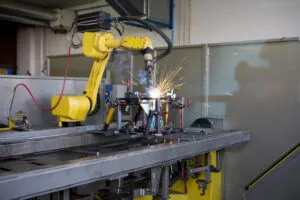
As machine complexity has increased, traditional anomaly detction methods have proven insufficient
Industrial processes and manufacturing systems depend on consistency and accuracy. Unusual data readings, or anomalies, can signal issues like equipment malfunction, faulty components or deteriorating sensors that disrupt the expected operational flow. AI-based anomaly detection helps engineers identify these potential problems early, which enables them to optimise maintenance schedules and improve process efficiency. According to Deloitte, 86% of manufacturing executives recognise that smart factories will drive competitiveness in the next five years, and AI will play an important role in manufacturing.
Complexity challenges
As machine complexity has increased in modern factories, traditional anomaly detection methods have proven insufficient. Engineers and technicians used to rely on manual data inspection or automated alerts when sensor values crossed defined thresholds. Today, engineers cannot analyse thousands of sensors simultaneously, inevitably missing anomalies that manifest as complex, hidden patterns across many sensors.
To meet these challenges, engineers in the manufacturing industry are using AI to improve the scale and accuracy of anomaly detection. AI algorithms can be trained on massive amounts of data from thousands of sensors to pinpoint complex anomalies that humans cannot identify by eye. By combining the scale of AI with the contextual domain knowledge of engineers, manufacturing organisations can create a comprehensive anomaly detection solution.
Anomaly strategy
Designing AI-based anomaly detection is a comprehensive process, from planning and data gathering to deployment and integration. Engineers must have a deep understanding of both algorithm development and the operational environment to develop a solution that can effectively identify potential issues.
The design process for an AI-based anomaly detection system begins with problem definition. This involves assessing the available sensor data, the components or processes, and the types of anomalies that could occur. For organisations new to AI, it is important to start with a scoped proof-of-concept project whose success will provide clear value to the organisation before moving on to larger initiatives.
High-quality data is crucial for AI systems. Engineers must first define what constitutes an anomaly and the conditions that categorise data as anomalous. Gathering data involves using sensors to continuously monitor equipment and processes, and manual checks to ensure data accuracy.
Data exploration
Most data for industrial anomaly detection comes from sensors that collect time series data such as temperature, pressure, vibration, voltage, and other measurements collected over time. It may also include related quantities like environmental data, maintenance logs, and operational parameters. The first step in designing an anomaly detection algorithm involves organising and preprocessing the data so that it is suitable for analysis. This includes reformatting and restructuring data, extracting the relevant pieces to the problem, handling missing values, and removing outliers.

Unexpected patterns in sensor data (anomalies) may indicate a faulty component or a degraded sensor.
The next step is to select an anomaly detection technique, which requires assessing the characteristics of the data, nature of the anomalies, and available computational resources.
Model selection and training
Experimenting with different training approaches for an AI model is crucial to find the best fit for a specific dataset. At a high level, AI techniques can be divided into supervised and unsupervised learning approaches depending on the type of data available.
Supervised learning is used for anomaly detection when chunks of the historical data can be clearly labelled as normal or anomalous. Labelling is often done manually by engineers who can align it with maintenance logs or historical observations. By training on this labelled data set, the supervised learning model learns relationships between patterns in the data and their corresponding labels (see Fact File – Plastic Packaging).
Many organisations do not have the labelled anomalous data required for a supervised learning approach. This may be because anomalous data has not been archived, or because anomalies do not occur often enough for a large training dataset. When most or all of the training data is normal, unsupervised learning is needed.
In an unsupervised learning approach, the model is trained to understand the characteristics of normal data, and any new data that is outside the normal range is flagged as an anomaly. Unsupervised models can analyse sensor data to identify unusual patterns that may indicate a problem, even if that type of failure has not been previously encountered or labelled.
Feature engineering
Although some AI models are trained on raw sensor data, it is often more effective to extract useful features from the data before training through a process called feature engineering.
Feature engineering is the process of extracting useful quantities from raw data, which helps AI models learn more efficiently from the underlying patterns. Experienced engineers may already know the types of features that are important to extract from the sensor data. Interactive tools can extract and rank the most relevant features in a data set to enhance the performance of supervised or unsupervised AI models.
Some types of data, such as images or text, benefit from deep learning approaches that can extract patterns automatically without requiring explicit feature extraction (See Power Cables Fact File). These deep learning approaches are powerful, but also require larger training datasets and computational resources.
Validation and integration
Validating and testing AI models ensures their reliability and robustness. Typically, the data can be split into three parts: training, validation, and test sets. Training and validation data are used to tune the model parameters during the training phase, and test data is used after the model is trained to determine its performance on unseen data. Engineers can also evaluate the model using performance metrics, such as precision and recall, and fine-tune to meet the needs of the specific anomaly detection problem.
A trained and tested AI model becomes useful when it is deployed in operation and begins making predictions on new data. When selecting an appropriate deployment environment, whether edge devices close to the manufacturing process to on-premises servers and cloud platforms with nearly unlimited computational power but higher latencies, factors like computational needs, latency, and scalability should be considered.
Deployment compiler and coder tools enable engineers to generate standalone applications and code that can be integrated into other software systems.
Integration requires developing application programming interfaces for access to the model’s predictions and establishing data pipelines to ensure the model receives properly formatted and pre-processed input. This ensures the model works with other components of the application or system and delivers its full value.
By combining AI algorithms with engineering expertise, factories can minimise defects, streamline upkeep and maximise output. Integrating AI into manufacturing processes may be complex, but the potential rewards are immense. As the manufacturing industry evolves, the role of AI in driving innovation and operational excellence will continue to grow.
Case Study
Plastic Packing
It is possible to experiment with multiple machine learning methods at once to see which model performs best. Packaging and paper products manufacturer, Mondi Gronau, used the Classification Learner in MATLAB to develop a health monitoring and predictive maintenance application to identify potential issues with the machines, enabling workers to take corrective action and prevent serious problems.
The company’s plastic production machines are controlled by up to five programmable logic controllers (PLCs), which log temperature, pressure, velocity, and other performance parameters from the machine’s sensors. Each machine records 300-400 parameter values every minute, generating 7GB of data daily.
The trained model can predict whether a new chunk of sensor data is normal or anomalous.
Case Study
Power Cables
Underground power cable systems are less susceptible than overhead lines to lightning, wildfires and adverse weather events, but they are more expensive to repair and failures are more difficult to pinpoint and to restore.
It is estimated that approximately 90% of failures in underground cable systems are associated with partial discharge. This is a phenomenon which occurs when the electric field within the cable exceeds the ability of the dielectric insulation to withstand it. It produces high-frequency signals, typically, less than 100mW, which indicate dielectric deterioration. Detecting these signals early can prevent unexpected cable failures and allow for repair before failure occurs.
Underground cable service provider IMCORP used MATLAB to design and train deep learning networks using time series and image-based anomaly detection. The networks also identify the approximate location of partial discharge in the cable, the type of defect that produced it, and its severity.
About the author
Rachel Johnson is principal product manager, MathWorks
Related
